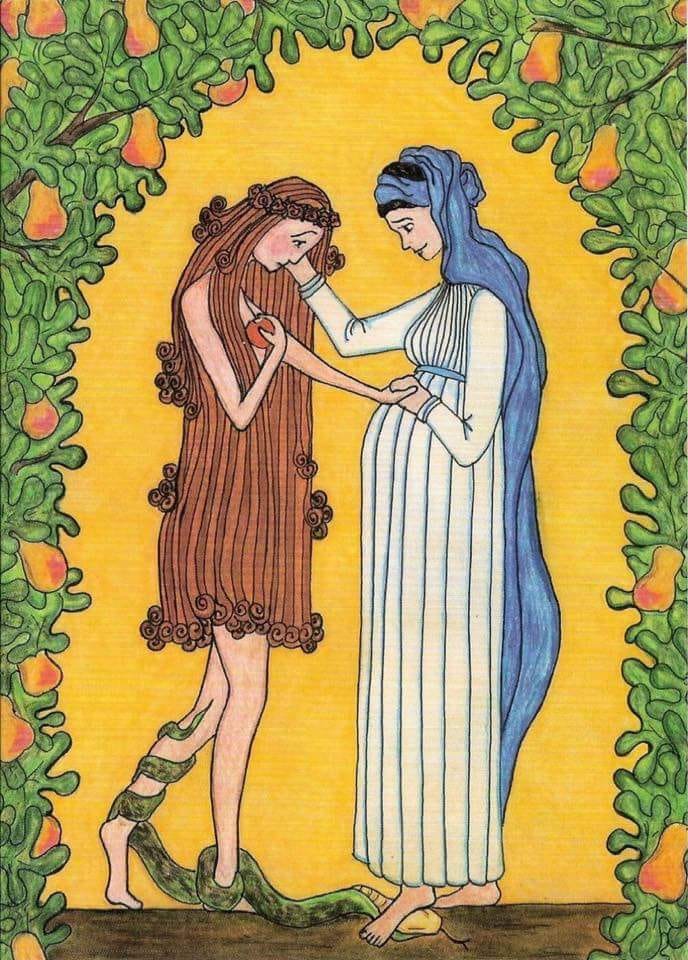An Apostate Considers Mary at Christmastime
A reflection on how certain old symbols carry new meaning
There’s an image that a minister friend shared years ago online that I haven’t been able to shake from my mind. It’s the portrait of an imagined meeting between the Bible’s Eve and Mary, created by Sr. Grace Remington, a Trappist nun in Mississippi. In it, Eve’s leg is snared by a serpent, and she gazes in a shamed way at Mary, with her hand on Mary’s swollen womb.
Eve is naked, except her hair, and she holds a bitten apple—fruit from the tree of knowledge of good and evil. Mary is draped in blue, per various interpretations, a symbol of her purity, her essential royalty, her nearness to divinity.
There’s so much that I, an agnostic, feminist woman might want to bemoan here. Why, oh, why, are they two, thin-armed white ladies? Why, if there’s space to visualize Genesis’s original sin, does it all still fall to Eve, alone? Why is Mary equipped to help the other woman confront her shame by way of her fertility? It captures all the tropes that have long reduced women into simple archetypes, the (rebellious) Eve and the (obedient) Mary. That whole, “Death through Eve, life through Mary” thing.
And yet, there’s an element I cannot shake, and I think it’s their expressions and the intimacy between them, two figures about whom stories have been told for generations, as if caught in a private moment between a girl thrust into womanhood and her great-(times many)-grandmother frozen in her own youth. It’s the good, good girl, with her foot on the snake’s neck.
I was raised mainline Protestant. This means Mary wasn’t an especially prominent figure in my religious imagination. If there was a Christmas pageant (and I am not sure there always was), Mary was simply one of the roles, like Joseph, the angel, or a donkey.
I do remember though, in my twenties, after I’d long-since quit calling myself a Christian, my new husband and I drove on Christmas Eve to the small church of the pastor who had officiated our wedding. We didn’t normally attend church, but having been raised in it, ingrained habit demanded that we spend the night before what had become for us a cultural holiday, in a church with hymns and little white candles tucked into cardboard guards.
The pastor, a woman who had led my confirmation class and taught me most of the things I’d once loved about faith, shared pastoral duties with her husband that night. They traded off preaching a sermon that was ostensibly about the birth of their own first child. They were young then, scared, trapped in that painful, anxious bardo of new life about to become.
I got swept up in the story, as I had so many times before in her stories. And through her, I found an entry-point into the other tale running parallel: that of a young woman, scared out of her mind, forced to travel with her fiancé for a census when she was far too pregnant. There’s no place to stay, an angel appears. It was overwhelming.
But in the midst, was a girl. Just a girl.
Not the Madonna.
Not the Mother of God.
A girl.
And despite all my heartbreak from falling away from the church, for one night, as flame passed candle-to-candle and a group of mostly strangers sang Silent Night, I could care about her story, and even that of her baby—because it was all still her story. It was a promise, not yet fulfilled or broken.
Keep reading with a 7-day free trial
Subscribe to In Polite Company to keep reading this post and get 7 days of free access to the full post archives.




